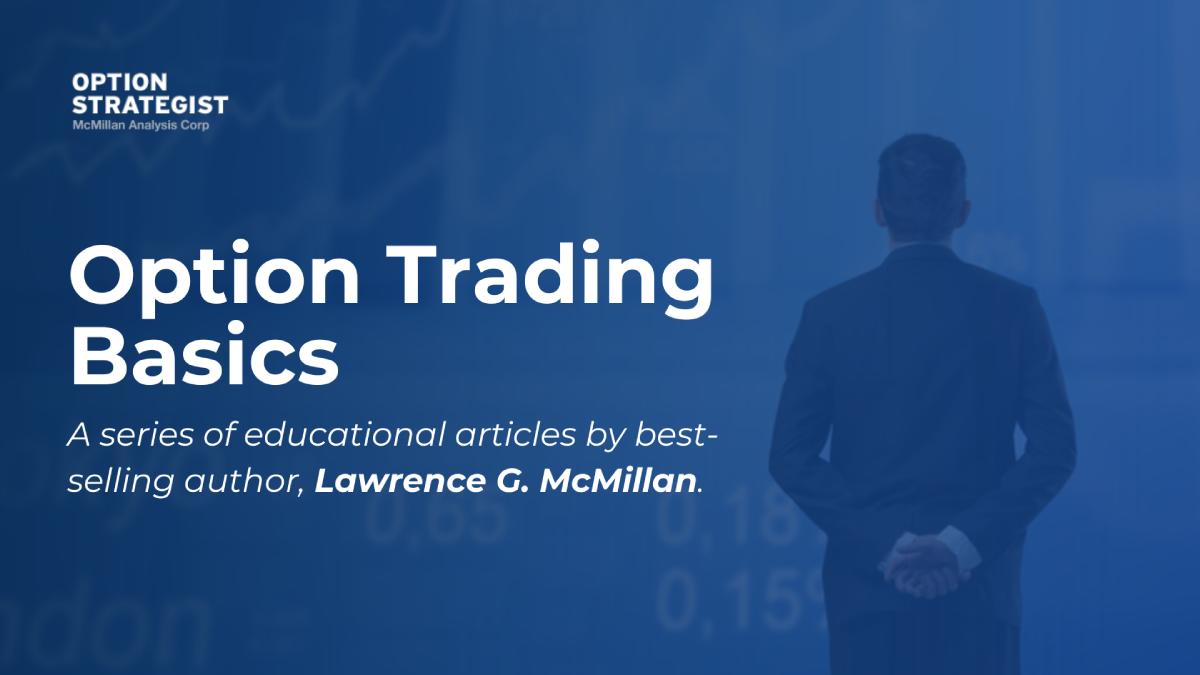Ends Jan 5, 2026.

By Lawrence G. McMillan
This article was originally published in The Option Strategist Newsletter Volume 5, No. 2 on January 25, 1996.
It's been almost a year since we addressed this topic. If this article is the springboard for a market like we had last year, then you won't need portfolio insurance. However, it never hurts to know about it, especially with the market being at such lofty levels, and many investors sitting on large unrealized gains in their stock portfolios.
Derivatives — both futures and options — lend themselves well to helping protect a portfolio of stocks from loss if the market declines. You can either sell futures against your portfolio, or you can buy puts. If you sell futures against your entire portfolio, you are essentially removing all profit and loss potential, except for tracking error ("tracking error" is the term that describes the difference in performance between the derivative that you are hedging with and your actual portfolio). Most investors do not want that much of a hedge; rather, they prefer to buy some (out-of-the-money) puts as an insurance policy against disaster.
The use of futures for portfolio insurance was popular in the '80s, but lost most of its supporters when the strategy didn't work as anticipated during the crash of 1987. Today, the purchase of index puts (often financed by the simultaneous sale of out-of-the-money calls) is the popular strategy.
If you have a diversified portfolio, you can purchase OEX or SPX puts against your stock holdings. However, if your portfolio is concentrated mostly into a specific sector, you might be better served by buying sector puts on the appropriate indices (technology, gold, utilities, etc.).
As with any type of insurance, you need to make a decision on two things: 1) the length of the insurance, and 2) the deductible portion that you are willing to assume. The bigger the deductible that you assume, the lower your insurance premiums will be. For example, many self-employed individuals have opted for high-deductible health insurance; they are willing to pay a couple of thousand dollars of medical expenses themselves, but are insured for anything over that amount — in case a real medical crisis arises. The cost of that form of insurance is much lower than a normal individual policy.
The type of insurance you select for your stock portfolio can be structured in a similar manner. The "deductible" portion of portfolio insurance is the distance between the current index value and the striking price of the out-of-the-money put that you are purchasing. With OEX at 585, you might buy December 575 puts and have very little deductible — only 10 OEX points, or about 2%. This means that if your portfolio performs in line with OEX, that your portfolio would be protected if OEX fell below 575. Your portfolio would lose money while OEX declined from 585 to 575, but below that level it would be protected.
This "low-deductible" policy would be fairly costly insurance — the puts would be rather expensive since they're not very far out-of-the-money. On the other hand, you might decide to buy the 550 strike, which has a much larger deductible of 35 OEX points, or 6%. That would be less costly because the puts are farther out-of-the-money.
It really isn't too difficult to determine how many puts you need to buy in order to hedge your portfolio. You must adjust your portfolio's volatility to match that of the index you are using as a hedge. You do that by dividing each stock's historical volatility by the historical volatility of the index; we call this "implied Beta". If you are using a broad-based index, you could use the actual Beta of the stock instead. Here's a quick example:
Suppose that one owns 3000 IBM (priced at 102), 5000 GM (50), and 4000 AT&T (65). This portfolio has a market value of $816,000. The volatility adjustment is as follows, assuming that the "market" volatility is 12%:
| Stock | Volatility | Implied Beta | Adjusted Mkt. Value |
| IBM | 36% | 3.00 | 918,000 |
| GM | 30% | 2.50 | 625,000 |
| AT&T | 24% | 2.00 | 520,000 |
| Total: | 2,063,000 |
Thus, one needs to hedge $2,063,000 of "broad market" value because this portfolio is more volatile than the market. If one uses the 550 strike in OEX, then that strike represents $55,000 of protection (550 × 100 per point). It would take 38 of these puts to hedge the portfolio (2,063,000 ÷ 55,000 = 37.51).
Finally, one must decide on the length of the insurance policy. An April 550 put costs $400; a December 550 put costs $1400; and a December (1997) 550 put costs $2500. So, purchasing 37 of these could be expensive if one opts for the longest policy, although the annualized cost of the insurance is always lowest for the longer-term puts.
This article was originally published in The Option Strategist Newsletter Volume 5, No. 2 on January 25, 1996.
© 2023 The Option Strategist | McMillan Analysis Corporation

